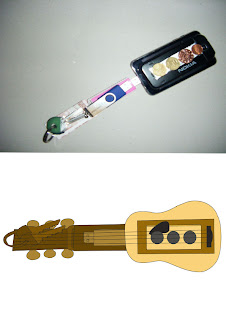Picasso, Pablo.
Still Life with Violin and Fruit, 1912.
After the spareness of Picasso's papiers colles with newsprint from December 1912, this "Still Life with Violin and Fruit"...delights us with its indulgence and provocation of our senses. It has the charming, and, at that time, rare combination of a violin with a compote of fruit on a table behind a ladder-back chair.
He fashioned the bowl of the compote deftly out of newsprint, as he did a skirt for the table, a support for the scroll of the violin, and a rectangle behind the glass that leans toward the right. He also used part of the masthead to indicate the newspaper itself resting on the table.
Although Picasso worked positively with our pleasure in pattern and color, he did introduce ambiguities into the work, for example, in giving the table two tops, one faux bois and angular, the other white and round, or the compote two bases, one the pillarlike pedestal, the other a combination of angles and the profile of the faux bois soundboard of the violin. But it is the violin that he made most paradoxical by tearing it apart turning one profile of its soundboard into imitation wood-graining, another into a heavily textured and contoured area of paint, pasting on paper for the light and dark side of the fingerboard and the beautiful blue paper for its sound holes and bridge, and then drawing strongly over the newsprint to transform the violin's scrolls into eyes and its pegs into sprouting double moustaches. The degree to which Picasso broke apart this violin letting us look at it from different directions in different, if contiguous, spaces, can be seen by comparing it with one of the purer papiers colles, "Violin" where the newspaper clippings have never been securely identified but since they refer to an incident in the Balkan War of 26 November 1912, they must have been printed the next day or the day after that. This violin is much simpler, more restrained, and definitely more stable as it stands erect with almost military precision. In "Still Life with Violin and Fruit", the musical instrument, on the other hand, tilts dangerously to the right and contains within it all sorts of rhythmic relationships that seem to lead appropriately to the expressive scroll and pegs. In apposition to the violin is the retiring compote whose rectangular white pedestal leans insecurely to the left but is somewhat stabilized by the vertical of the chair below. Nevertheless, the compote and the violin need each other to achieve equilibrium, which gives the work much of its animation.




